alpha-bungarotoxin receptors contain alpha7 subunits in two different disulfide-bonded conformations
- PMID: 10402471
- PMCID: PMC2199736
- DOI: 10.1083/jcb.146.1.203
alpha-bungarotoxin receptors contain alpha7 subunits in two different disulfide-bonded conformations
Abstract
Neuronal nicotinic alpha7 subunits assemble into cell-surface complexes that neither function nor bind alpha-bungarotoxin when expressed in tsA201 cells. Functional alpha-bungarotoxin receptors are expressed if the membrane-spanning and cytoplasmic domains of the alpha7 subunit are replaced by the homologous regions of the serotonin-3 receptor subunit. Bgt-binding surface receptors assembled from chimeric alpha7/serotonin-3 subunits contain subunits in two different conformations as shown by differences in redox state and other features of the subunits. In contrast, alpha7 subunit complexes in the same cell line contain subunits in a single conformation. The appearance of a second alpha7/serotonin-3 subunit conformation coincides with the formation of alpha-bungarotoxin-binding sites and intrasubunit disulfide bonding, apparently within the alpha7 domain of the alpha7/serotonin-3 chimera. In cell lines of neuronal origin that produce functional alpha7 receptors, alpha7 subunits undergo a conformational change similar to alpha7/serotonin-3 subunits. alpha7 subunits, thus, can fold and assemble by two different pathways. Subunits in a single conformation assemble into nonfunctional receptors, or subunits expressed in specialized cells undergo additional processing to produce functional, alpha-bungarotoxin-binding receptors with two alpha7 conformations. Our results suggest that alpha7 subunit diversity can be achieved postranslationally and is required for functional homomeric receptors.
Figures



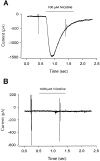
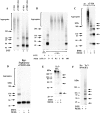
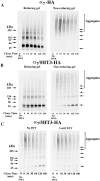


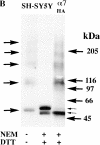
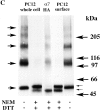


Similar articles
-
Molecular characterization of Dalpha6 and Dalpha7 nicotinic acetylcholine receptor subunits from Drosophila: formation of a high-affinity alpha-bungarotoxin binding site revealed by expression of subunit chimeras.J Neurochem. 2004 Jul;90(2):479-89. doi: 10.1111/j.1471-4159.2004.02499.x. J Neurochem. 2004. PMID: 15228604
-
Neuronal alpha-bungarotoxin receptors differ structurally from other nicotinic acetylcholine receptors.J Neurosci. 1997 Nov 1;17(21):8201-12. doi: 10.1523/JNEUROSCI.17-21-08201.1997. J Neurosci. 1997. PMID: 9334396 Free PMC article.
-
Similarity between rat brain nicotinic alpha-bungarotoxin receptors and stably expressed alpha-bungarotoxin binding sites.J Neurochem. 1996 Jul;67(1):145-54. doi: 10.1046/j.1471-4159.1996.67010145.x. J Neurochem. 1996. PMID: 8666985
-
The nicotinic acetylcholine receptor gene family: structure of nicotinic receptors from muscle and neurons and neuronal alpha-bungarotoxin-binding proteins.Adv Exp Med Biol. 1991;287:255-78. doi: 10.1007/978-1-4684-5907-4_22. Adv Exp Med Biol. 1991. PMID: 1759611 Review. No abstract available.
-
The fall and rise of neuronal alpha-bungarotoxin binding proteins.Trends Pharmacol Sci. 1992 Nov;13(11):407-13. doi: 10.1016/0165-6147(92)90125-p. Trends Pharmacol Sci. 1992. PMID: 1332232 Review.
Cited by
-
Identification and characterization of poly(I:C)-induced molecular responses attenuated by nicotine in mouse macrophages.Mol Pharmacol. 2013 Jan;83(1):61-72. doi: 10.1124/mol.112.081497. Epub 2012 Oct 1. Mol Pharmacol. 2013. PMID: 23028093 Free PMC article.
-
Rapid upregulation of alpha7 nicotinic acetylcholine receptors by tyrosine dephosphorylation.J Neurosci. 2005 Apr 6;25(14):3712-23. doi: 10.1523/JNEUROSCI.5389-03.2005. J Neurosci. 2005. PMID: 15814802 Free PMC article.
-
Nicotinic acetylcholine receptors: Conventional and unconventional ligands and signaling.Neuropharmacology. 2020 May 15;168:108021. doi: 10.1016/j.neuropharm.2020.108021. Epub 2020 Feb 28. Neuropharmacology. 2020. PMID: 32146229 Free PMC article. Review.
-
Neuronal alpha-bungarotoxin receptors are alpha7 subunit homomers.J Neurosci. 2000 Jan 1;20(1):133-9. doi: 10.1523/JNEUROSCI.20-01-00133.2000. J Neurosci. 2000. PMID: 10627589 Free PMC article.
-
Palmitoylation of huntingtin by HIP14 is essential for its trafficking and function.Nat Neurosci. 2006 Jun;9(6):824-31. doi: 10.1038/nn1702. Epub 2006 May 14. Nat Neurosci. 2006. PMID: 16699508 Free PMC article.
References
-
- Alkondon M., Albuquerque E.X. Diversity of nicotinic acetylcholine receptors in rat hippocampal neurons. I. Pharmacological and functional evidence for distinct structural subtypes. J. Pharmacol. Exp. Ther. 1993;265:1455–1473. - PubMed
-
- Alkondon M., Rocha E.S., Maelicke A., Albuquerque E.X. Diversity of nicotinic acetylcholine receptors in rat brain. V. Alpha-bungarotoxin-sensitive nicotinic receptors in olfactory bulb neurons and presynaptic modulation of glutamate release. J. Pharmacol. Exp. Ther. 1996;278:1460–1471. - PubMed
-
- Blount P., Merlie J.P. Molecular basis of the two nonequivalent ligand binding sites of the muscle nicotinic acetylcholine receptor. Neuron. 1989;3:349–357. - PubMed

